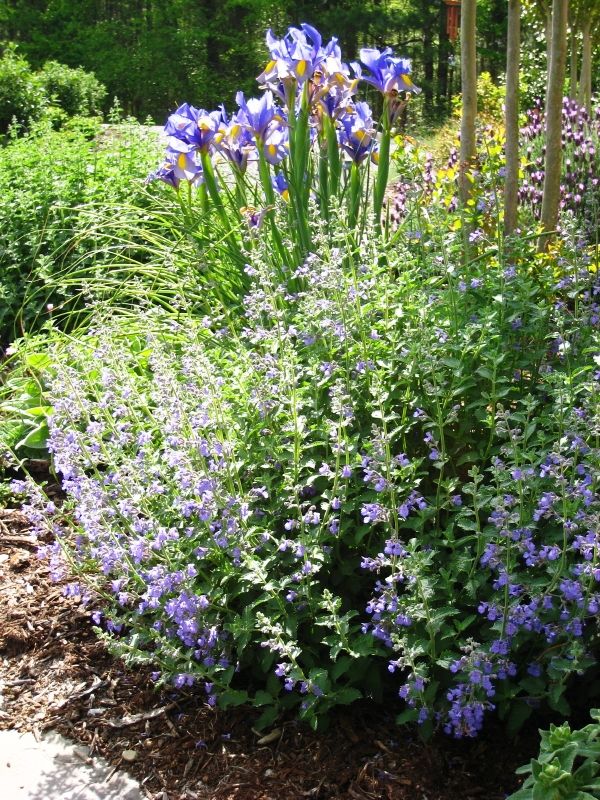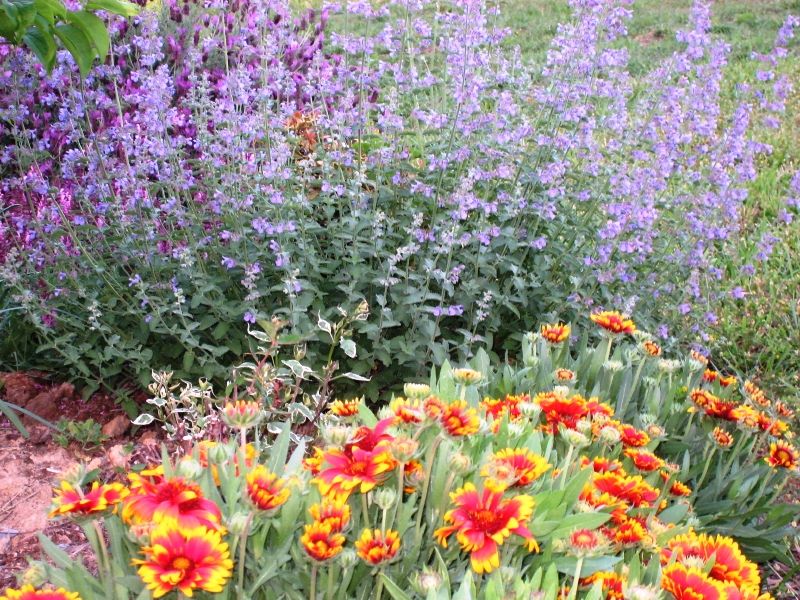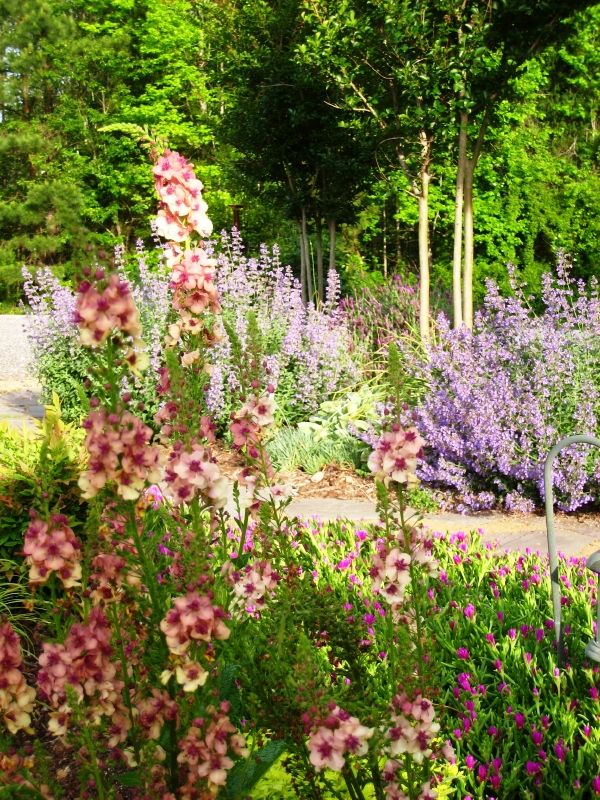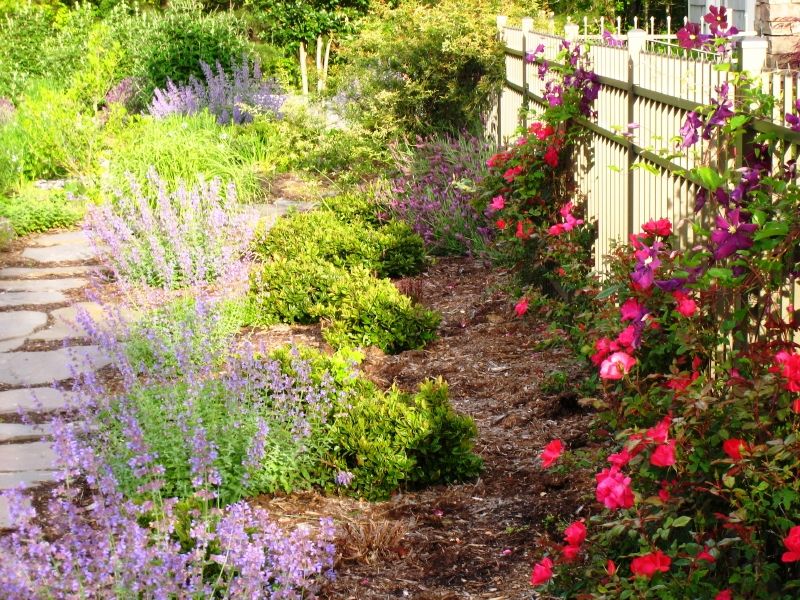Throughout my garden, I've used nepeta extensively. It was the first perennial that I found to be truly deer and rabbit proof. However, I've come to love it for so many reasons other than pest free attributes.
The lavender-blue blooms of the 'Six Hills Giant' or 'Walkers Low' Nepeta work well with almost every color combination. The color also works well to provide a break between clashing colors in a garden. The grey-green foliage has a spicy fragrance and mounds beautifully all summer long if sheared between blooms. The easiest way to shear nepeta is using cordless trimmers.
Nepeta 'Six Hills Giant' blooms early enough in April to have some overlap with Dutch Iris. Since this nepeta is large and frilly, it also serves to hide the Dutch iris foliage after the flowers are gone.

I seem to always underestimate the amount of space needed for nepeta 'Six Hills Giant' or 'Walkers Low'. If you grow either one of these, leave at least three feet of space for each plant. You can divide the nepeta when they first begin to emerge in early spring. Just take a shovel and cut out a section, then backfill the hole with soil.
'Six HIlls Giant' is taller than 'Walkers Low' and creates a larger mass. 'Walkers Low' is more like a flowering ground cover.
In the next photo, nepeta 'Six Hills Giant' is serving the purpose of dividing up color schemes in summer 2008. This fall, I moved the rose pink salvia and to another location and replaced them with three agastache 'Coronado' which is an apricot color.
Just to the left of the nepeta is an osmanthus goshiki shrub that has tinged bronze new growth. The evergreen osmanthus will be yellow and green after a few weeks in summer.
The rosey plumes are salvia 'Rose Queen'. In front is a hypericum 'Albury Purple'. I love the foliage of the hypericum, but the success rate has been mixed with that variety.

That same nepeta in the above photo is also in the next photo. In this instance, the color and size of the nepeta buffer two color schemes that wouldn't work together. Actually, these gaillardia were mislabeled as yellow and turned out to be orange and gold. Since I have now moved the rose perennials, I am expanding the gaillardia in this section. I learned to love this gaillardia as it bloomed almost non-stop all summer. Even the seed heads looked good for a long time, so deadheading wasn't mandatory to keep up appearances.

The verbascum in the following photo has been in place for two years. It didn't perform too well at first, but in 2008, it was looking good, with at least three rounds of blooms. It is growing at the junction of the outer garden path and the flagstone walkway to our front garden gate. Once again, you can see the nepeta 'Six Hills Giant' in the background across the walkway.
I finally had to move the largest nepeta as I was constantly shearing it back as it grew quickly over the walkway. I'll be redesigning that area in spring 2009, using something less likely to overflow onto the walkway.

In the next photo, nepeta 'Walkers Low' is used for continuity along one side of the outer garden path. I prefer this nepeta for edging a walkway as the foliage spreads wide, but stays low, creating a nice ground cover.

Those are carrisa hollies outside the fence and Knock Out® roses inside the fence. Purple clematis is growing along the fence in this section. The hollies and roses were planted by the landscaper who installed our fence. The deer didn't touched the roses (that can be reached through the fence) until late August.
The design of this garden area is still underway. This fall, I planted Dutch iris 'Telstar' and allium 'Purple Sensation' along with the nepeta to add more color in the border for spring.
Larkspur seeds were sown along the fence line in October and the seedlings have already emerged. The larkspur is deer resistant. I'm excited about creating a cottage garden look with the mix of irises, allium, nepeta, roses and clematis.
While the nepeta x faassenii varieties like hot, dry conditions and well draining soil, there is a subsessillis variety that is supposed to be suitable for moist areas. I have the susessillis in blue and rose. I'll have to wait until summer of 2009 to report on how well these perform.
If you are looking for a plant with the following attributes, consider nepeta 'Six Hills Giant' or 'Walkers Low' for a mixed border or perennial garden. Nepeta is a favorite for honey bees, butterflies and hummingbirds.
Zones 3-8
Full sun
Deer resistant
Rabbit resistant
Japanese Beetle resistant
Drought tolerant
Long bloom season
Easy care (cut back at the end of winter and again after each bloom)
Easy to divide (divide by shovel)
Photos and story by Freda Cameron


